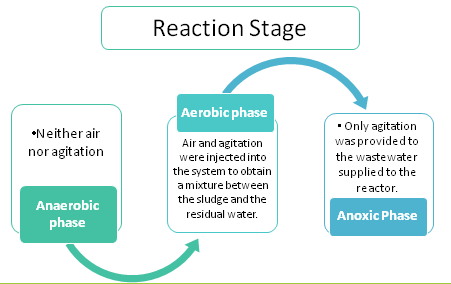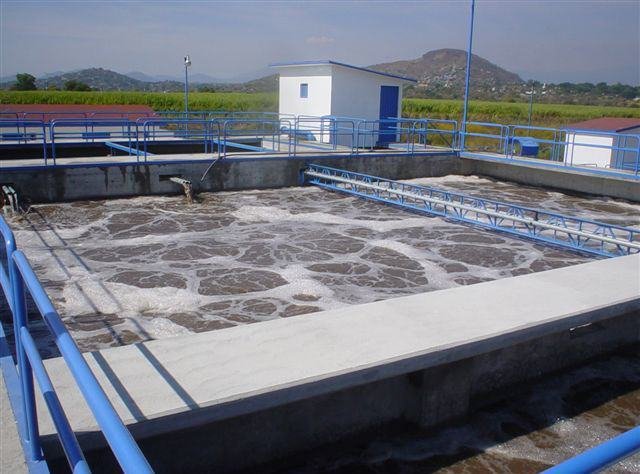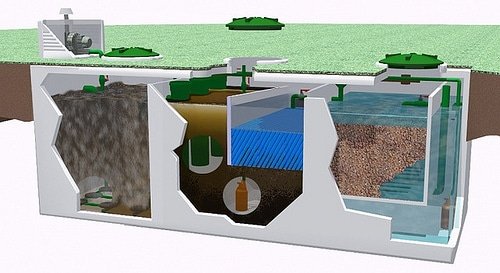Sequential Biological Reactor


Hello friends of Steemit, this time I have come to talk to you about sustainable energy through a biological reactor, maybe many of you ask yourself, and what is that? That's what this post is about, I'll try to explain it in the best way ...
My person (José Bernal- left) with Manuel Rodríguez (right), both young Civil Engineers graduated from the University of Zulia (LUZ), we have shown and share a great interest in sanitary engineering applied in the environmental field, showing also concern for the lack of awareness and interest of the Latin society, especially the Venezuelan society before the problem of the contamination of the bodies of water and sewage systems. That is why we have carried out several investigations of this nature, in order to treat the wastewater, and leave it suitable to be disposed in the sewage networks. These waters are generated mainly by the industrial sector, which without much shame, these highly toxic and polluted waters end up in our bodies of water; as for example the Lake of Maracaibo and Valencia. All this problem is sponsored by a government devoid of civic culture and even more ecological, without any interest in enforcing the regulations in force in regard to the matter.
The results of these investigations have been successful, in its first phase at the laboratory level and subsequent to it, applying them in real life. All this under the tutelage of Prof. Eng Químico Sedolfo Carrasquero (in the center of the image). Together with him, we have had the opportunity to make several publications of scientific articles in magazines of France, as well as to participate in sustainable engineering projects in Latin America such as "The Odebrecht Prize", believing and always betting on a better country and world, ratifying that in this country there is plenty of talent, and sooner or later we will begin to give value to our community of professionals.
Below is a brief review of the work that is done within the laboratories of the Department of Sanitary and Environmental Engineering. In this opportunity a Sequential Load Reactor (SBR) is presented, its functions, utilities and the results that can be achieved. Without further ado, let's start by defining some basic concepts.
What is water?
Water is an indispensable resource for life to develop on our planet, being a very stable chemical compound, formed by hydrogen and oxygen atoms, of the H2O formula. The water is odorless, insipid and colorless, and its enormous presence on Earth (71% of it is covered with water) determines in large part the existence of life on our planet. Water is the only substance that exists at ordinary temperatures in all three states of matter. It exists in a solid state like ice, found in glaciers and polar ice caps, and in the form of snow, hail and frost. As a liquid it is found in rain clouds formed by drops of water, in the form of dew on vegetation, and in oceans, seas, lakes, rivers, etc. As gas, or water vapor, it exists in the form of fog, steam and clouds. Source


Sources (1,2)
But when chemical substances or pathogenic organisms come into contact with it due to industrial processes, population growth, and constant technological development, there is alteration in its original composition, being reflected in physical properties such as color, smell and taste, being the first to identify and diagnose when the water is contaminated, causing damage to the health of those who consume it and its receiving environment.


Industrial effluents are characterized by a very diverse and complex composition, due to the fact that they are generated by different production systems, in which the raw materials and inputs that are used provide particular characteristics to each type of wastewater generated, which is why It is convenient to apply a treatment that can adapt to the large number of pollutants that are contained in these effluents.

The untreated discharge of increasing volumes of wastewater in rivers, lakes or estuaries, rapidly decreases the self-purification capacity of these ecosystems and the receiving water masses lose the necessary properties to maintain their equilibrium.
Venezuela has regulations such as Decree 883 (Official Gazette, 1995) and the Water Law (2007), however, the majority of wastewater discharges, both domestic and industrial, are not subject to to no treatment of purification, but they are simply discharged to the municipal drainage system and water bodies (rivers, lakes, reservoirs), allowing natural systems, with greater or lesser efficiency, to degrade waste naturally.

An example of polluting effluents are those that come from the processing industries of meat products, which due to the presence of organic matter, nitrogen, phosphorus, fats, among others, generate problems such as the eutrophication of natural currents, endangering life in aquatic ecosystems.


That is why there is a need to simultaneously remove organic matter, nitrogen and phosphorus in this type of effluents through biological treatments with unconventional activated sludge systems, such as reactors by sequential loading SBR ( Figure 1). These SBR, in addition to being effective in the elimination of organic matter and nitrogen to treat effluents from meat industries, are more economical and generate fewer byproducts than conventional biological systems.

What is a Secuencial Biological Reactor?
The sequential biological reactors (SBR) are discontinuous reactors in which the residual water is mixed with a biological sludge in an aerated medium. The process combines the three stages in the same tank, based on the use of a single reactor that operates in sequential discontinuous form.
The stages are shown below:

How a pilot or laboratory scale reactor is constituted?
Why this dosage?
How is the sequence for the biological process?
Once the water in the cylinder, oxygen injection must be done to aerate the mixture through an air compressor connected to a transparent flexible pipe of 5 mm, linked in series with a diffuser device (flexible pipe with holes) arranged in the bottom to supply air upstream of the mixture contained in the reactor.

Below is shown with images, the process previously explained.



The typical phases that constitute the operation of a reactor by sequential loading, with its sequence to treat industrial effluents:
Preliminary treatment

Primary treatment

Secondary Treatment
Biological processes are used, whose objective is to remove most of the organic matter and nutrients such as nitrogen and phosphorus, through biochemical processes, in which microorganisms are responsible for biodegradation.

Third treatment
The objective of this treatment is to eliminate the concentration of organic matter remaining from a secondary treatment, disinfect the treated wastewater to eliminate pathogenic microorganisms, eliminate color and undesirable odors, remove residual detergents, phosphates and nitrates, which cause foam and eutrophication, respectively.

You have asked yourself, what are the advantages of using an SBR??

Some of the advantages of the SBR are:
• Effluents of high quality and lower amount of solids in suspension, due to the static and controlled decantation that the system allows, influencing a direct reduction in other effluent quality control parameters.
• It has greater resistance to sudden changes in temperature.
• It allows to control the gross water load cycles, establishing criteria of how, when and how to perform them.
• Once the operating parameters of the system have been established, in view of the diversity of discharges that may exist in an industry, the control of the operation of the system is simple and automatic.
• Because a single tank is required to perform the whole process, achieving greater stability and flexibility.
• This type of technology is ideal, due to its adaptability and tolerance to variations in organic load, for those cases where there are constant load and volume conditions.
• On the other hand, the investment costs are lower since they do not require the typical secondary decanters, thus presenting a compact design and is an ideal solution for those industries that do not have enough space. An SBR requires much less space than conventional systems such as activated sludge.
Likewise, some of the disadvantages of SBRs are mentioned, which are few compared to other types of treatment:

• Sequential biological reactors require greater technical training of the personnel who will exploit it due to the requirement to change the parameterization of the operation of the system in response to changes in the quality of the industry's discharge.
• They are systems that need greater investments in the aeration system and greater demand of energy on a timely basis, due to the discontinuous feeding of the system, being of great importance a good sizing and with margin of safety, in the aeration system.
• It is a technology that is not applicable to all types of organic effluent, the presence of toxic compounds can negatively affect the performance of this treatment, favored by toxic impacts by punctual feeding.
Some of the parameters that are studied in an effluent through an SBR are presented in Table 1:

Once explained that it is an SBR, what it needs, how it works and its results, we arrive at the:

From the social point of view, manages to awaken the consciousness of society, especially the agro-industry, food, and citizen by making understand the need to treat the wastewater generated and discharged into the urban sewage systems and bodies of water in the region , through the use of clean technologies. Otherwise, the environmental impact they generate is high and the price of damaging ecosystems is even greater, decreasing the quality of life on the planet.
Some sources cited:
Water, Energy and Environment Integral Services S.L.U (2015). Advantages and Disadvantages of sequential biological reactors. Wastewater info. Electronic resource. Consulted on: 4/2/2016
Angulo, N., Carvajal, K., Cardenas, C., Araujo, I., Morillo, G., Melo, P., Beltran, A., Diaz, A. (2015). Comparison of operational conditions of a sequential batch reactor in the treatment of a dairy effluent. Rev, Tec, Ing, Univ, Zulia, Vol 38. Nº 1, 50 - 57 2015.
Barajas, M. (2002). Biological elimination of nutrients in a sequential biological reactor. Doctoral Work in Biological Sciences. Department of Hydraulic, Maritime and Environmental Engineering. Universitat Politècnica de Catalunya. Barcelona, Spain. p.p. 3. 4. 5.
Caixeta, C., Cammarota, M., Xavier, A. (2002). Slaughterhouse wastewater
treatment: evaluation of a new three-phase separation system in a UASB reactor.Bioresource Technology. Pp. 81: 61 -69.
Caldera, Y. (2009). Efficiency of a wastewater treatment plant of a poultry industry. Accelerated Degree Program Doctorate of Science in Environmental Engineering. Tecana American University.
Carrera, J. (2001). Biological Elimination of Nitrogen in an effluent with high load. Department of Chemical Engineering. Doctoral thesis. Autonomous University of Barcelona. Spain.
Carrasquero, S., Marquina, D., Soto, J., Viloria, S., Pire, M., Díaz, A. (2015). Removal of nutrients in wastewater from a slaughterhouse using a sequential biological reactor. Neogranadine Science and Engineering, 25 (2): pp 43-60, 2015.
my god this post has a lot of good information
Thanks friend @julitonski, that's the idea, show all the tools we have to provide a grain of sand in this deteriorated world. The solutions are, only that this society and its governments are focused on things that are not so important.